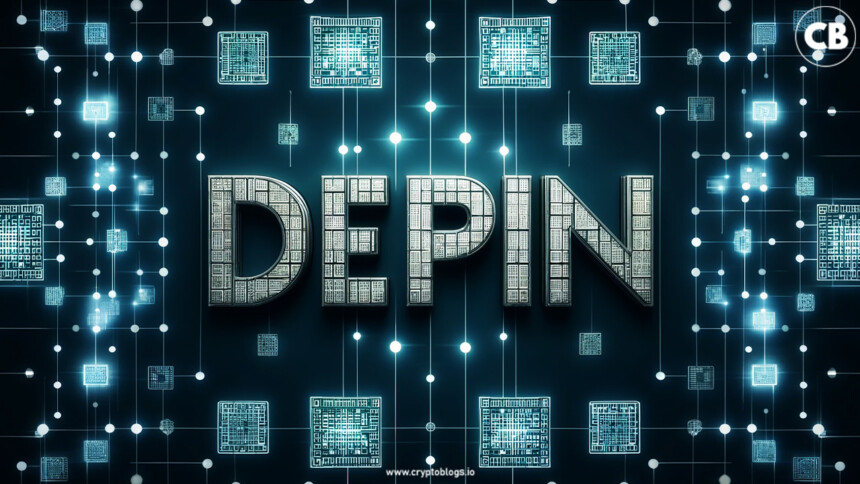The blockchain technology adoption is expanding day by day as several novel applications are launched in the market on a regular basis. We have witnessed the growth of blockchain space with the advent of decentralized finance (DeFi), NFTs, asset tokenization, and more. In addition to this, a new primitive of Decentralized Physical Infrastructure Networks (DePIN) has now come to the spotlight. Speculations are rife that this new application is set to revolutionize the tech industry.
In this article, we will discuss what is this trend of DePIN and what potential it holds for the future. We are also going to list the top DePIN projects that are leading this primitive.
What is DePIN?
DePIN represents applications that leverage blockchain technology and combine it with physical devices. These applications operate at the intersection of the latest hardware devices and the decentralized values put forward by blockchain. Both these elements enable a self-regulated infrastructure that improves the capability of existing systems in the current tech ecosystem.
The applications of DePIN have been in existence since the past few years but its gaining recognition only recently due to the massive success of projects like Render Network. The ability of DePIN applications democratizes infrastructure ownership, enhancing reliability and redundancy, while enabling accessibility of particular hardware on a global scale. By harnessing the values of decentralization and tokenized incentives, DePINs form a digital ecosystem where innovation takes a pivotal role and revamps how our surroundings work.
According to CoinGecko data, the market cap of the DePIN sector has now reached over $30 billion. It visualizes that this sector has matured and achieved huge traction from the crypto community as well as tech investors.
How DePINs Are Different From dApps?
While using the same technology in the foundation, the fundamental development of both dApps and DePINs are different. Decentralized applications (dApps) are basically software on blockchain that enables specific utilities like trading or financing whereas DePINs serve as a whole infrastructure. The applicability of dApps is limited to the crypto and decentralized finance (DeFi) space. DePINs on the other hand, go beyond and introduce blockchain functionality to real-world applications.
How DePINs Work?
DePINs inherit the principles of blockchain, decentralization, and tokenized economy. At its core, DePINs aims to decentralize the management, control, and ownership of a physical traditional application. Its main functionalities are based on technology like peer-to-peer (p2p) networking, smart contracts, and tokenization. By leveraging these mechanisms, DePINs create a reliable, transparent, and resilient decentralized infrastructure network which empower users to utilize physical resources while paying or being incentivized native cryptocurrency tokens.
DePINs extend the principles of decentralization to the real world by managing and incentivizing the use of physical infrastructure using blockchain technology. The application of DePIN is likely to expand into sectors such as telecommunications, energy, and transportation with offering more efficient, secure, and cost-effective solutions compared to traditional models.
Top DePIN Projects in 2024
Below are the top 5 DePIN projects gaining traction in 2024 while offering innovative solutions integrated with blockchain technology and real-world infrastructures.
Akash Network
Launched in March 2018, Akash Network focuses on decentralized cloud computing services. It uses a marketplace model where developers can rent computing resources and give the native AKT token a utility. Akash Network is much cost-effective compared to existing traditional cloud services and it supports various tasks including AI applications.
Render Network
Render is one of the most promising DePIN projects that has made it to the list of 30 biggest crypto projects in 2024. It was launched in 2017 and it recently migrated to Solana to benefit from low fees and high throughput. Render Network offers decentralized rendering by allowing users to access decentralized graphical (GPU) power. It has a native token RNDR which is used to pay for rendering services and reward providers.
Arweave
Arweave was also launched in 2018 and its key functionality is permanent data storage on distributed ledgers. Arweave uses blockweave technology for decentralized and immutable data storage while ensuring censorship resistance. Its novel consensus – called Proof of Access – ensures that data stored on ledgers remain accessible and secure. Arweave has a native currency AR which is used to pay for data storage and incentivise node operators.
Filecoin
Known as one of the earliest crypto projects, Filecoin was launched in 2014 and it has been a DePIN project even before the term was invented. Filecoin provides decentralized data storage while using Proof of Replication and Proof of Spacetime mechanisms to ensure data integrity.
Future Of DePIN
While blockchain technology is in an emerging phase, DePINs have introduced a wider scope for the use of decentralized applications. The future of DePINs looks promising with it awaiting significant advancements. The potential integration of DePINs with the Internet of Things (IoT) artificial intelligence (AI), and decentralized governance could bring major innovations in the current tech landscape.
One of the most remarkable benefits of DePIN is decentralization which will continue to evolve and empower sustained ecosystems. Moreover, the credibility of DePIN will upscale existing infrastructures and revolutionize a number of sectors where user-to-user or user-to-entity communication is entailed.
However, there are also several challenges that these applications could face including issues of scalability and performance. Regulatory compliance will be also important as these projects grow, requiring an economic framework same as the current crypto ecosystem.
Also read: All About Artificial General Intelligence (AGI): Will AI Think Like Humans?
Final words
While still in the early stages, DePINs are fast emerging as a novel concept with the potential to revolutionize the tech industry. It is expected that a variety of real-world applications could be enabled by DePINs that could reshape the whole interaction between users and hardware devices. The potential DePIN applications in the field of healthcare, energy, data storage, and telecommunications will change the way the current system functions. As blockchain technology continues to evolve and decentralization is reaching a wider audience, the role of DePINs is expected to grow and form a paradigm shift within the tech sector.







